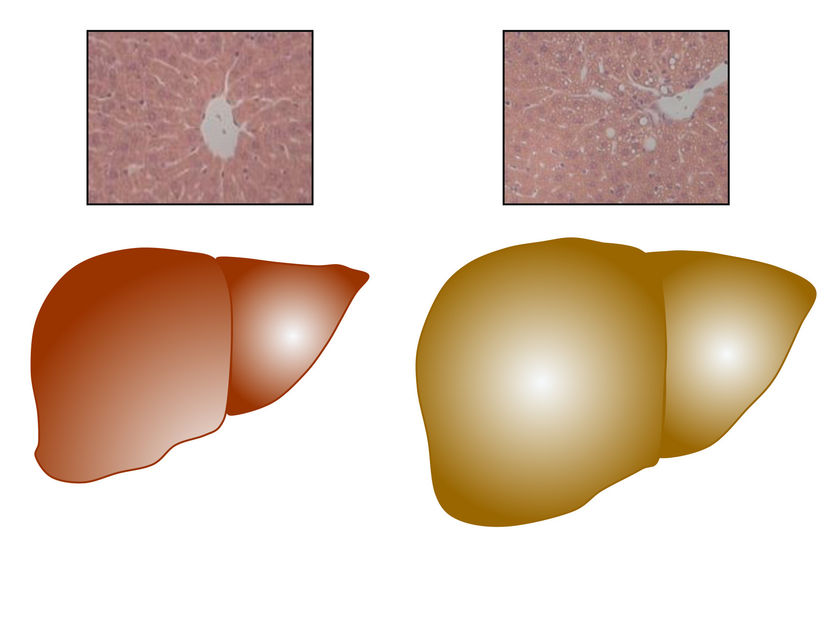Trigger for Fatty Liver in Obesity
Advertisement
Morbid obesity affects the liver: Almost one-third of all adults suffer from chronic fatty liver disease, which can lead to infections and even trigger cancer. Researchers at the University Children's Hospital Zurich and the University of Zurich have now found a signaling pathway in cells that play an important role in the development of fatty liver disease.

A healthy liver (left) can develo a steatosis (right).
UZH
In Switzerland, about every tenth adult suffers from morbid obesity. Such corpulence can not only lead to diabetes or cardiovascular disease, but also to fat accumulation in the liver. Worldwide, about 25 to 30 percent of all adults and increasingly children are affected by such steatosis – becoming the most frequent liver disease in recent years. Some patients suffer from inflammation that could lead to a scarred shrinkage of the liver (cirrhosis) or even cancer.
Receptor for programmed cell death activated
Despite the increasing frequency of obesity-related liver steatosis, there is currently insufficient knowledge about the origin of this disease. At the University Children's Hospital Zurich, researchers from the University of Zurich have identified a signaling pathway in liver cells that may contribute to the development of steatosis. In the process, the plasma membrane receptor Fas (CD95) is key; this cell receptor occurs in almost all human cells and is involved in programmed cell death (apoptosis). This self-destruction program is activated when cells are no longer functional or are even developing malignantly. Activation of the Fas receptor then induces apoptosis in these cells. A low-threshold activation of Fas, however, can trigger cell reproduction or an inflammatory response without cell death occurring.
Lack of Fas receptor protects against a fatty liver
“In our study, we were able to demonstrate in mouse models that Fas is activated within the scope of obesity and can therefore lead to the development of liver steatosis,” says Prof. Dr. med. Daniel Konrad, professor for endocrinology and diabetology from the University of Zurich and physician at the University Children's Hospital Zurich. “Mice missing Fas in their liver cells were protected against the development of obesity-induced fatty liver for the most part.” The animals are also considerably less insulin resistant. “Conversely, our study shows that an increased Fas content in the liver can lead to liver steatosis and insulin resistance, even in case of a normal body weight,” Konrad explains.
Permeable mitochondria inhibit lipid oxidation
The team of researchers found indications that an activation of Fas affects the mitochondria: Their capacity to oxidize fatty acids is limited and therefore leads to the accumulation of lipids in liver cells. In the process, the protein-coded gene “BID” plays an important role. This gene is also involved in programmed cell death, leading to an increased permeability of the mitochondrial membrane. The researchers were able to demonstrate that mice with increased Fas content but simultaneously low BID content in the liver were protected against the development of fatty liver.
New therapy approach possible
The study therefore shows how both factors, Fas and BID, interact in case of obesity contributing to fatty liver disease. “The described signaling pathway of Fas and BID could serve as a novel target for a better treatment of fatty liver disease associated with obesity,” Daniel Konrad explains.
Original publication
Flurin Item, Stephan Wueest, Vera Lemos, Sokrates Stein, Fabrizio C. Lucchini, Rémy Denzler, Muriel C. Fisser, Tenagne D. Challa, Eija Pirinen, Youngsoo Kim, Silvio Hemmi, Erich Gulbins, Atan Gross, Lorraine A. O’Reilly, Markus Stoffel, Johan Auwerx, Daniel Konrad; "Fas Cell Surface Death Receptor controls hepatic lipid metabolism by regulating mitochondrial function"; Nature Communications; 7. September, 2017

























































